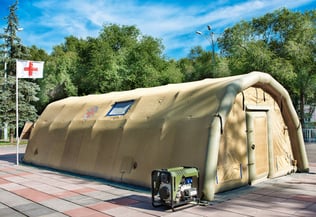Introduction to Unique Welding Applications with Miller Weldmaster
Miller Weldmaster has 50 years of experience in the industry. With countless industries served and thousands of machines sold, we are experts in welding principles and applications.
Thermoplastic welding is a versatile technique that finds applications in various industries, from inflatables and tents to aerospace and automotive. While most welding applications involve joining fabric components, there are unique welding applications that involve different materials and processes. Using heat, speed, and pressure, this welding technique is used for products we use every day. Thermoplastic welding can be used for creative welding projects that help make our lives easier and better.
With the advent of new materials and technologies, the possibilities for unique welding applications continue to expand, offering new solutions for complex manufacturing challenges.
Exploring Different Welding Technologies
Similar to metal welding, fabric welding has multiple different methods to create a strong and durable bond. Depending on the material, application, and run time, you will need a tailored welding solution. From Hot Air to RF and custom technology, you will need to find the best welding technology for your application. Miller Weldmaster offers many different types of technology. Check out in-depth breakdowns of each type, or keep reading to get our overviews of each!
Hot Air Welding
Hot air welding is a thermoplastic welding technology that uses hot air to melt and fuse plastic materials together. This technique is commonly used in the fabrication of plastic sheets, films, and membranes for applications such as roofing, flooring, and geomembranes. The process involves heating the plastic materials with a hot air gun or a welding machine until they reach their melting point. The materials are then pressed together and allowed to cool, creating a strong, permanent bond. Hot air welding is a versatile and efficient method that offers several benefits, such as minimal waste, high productivity, and reduced energy consumption. This welding technology can also be used with different types of thermoplastic materials, including PVC, polypropylene, and polyethylene, making it a popular choice for a wide range of industrial applications.
Hot Wedge Welding
Hot wedge welding is a thermoplastic welding technology that uses a heated wedge to melt and fuse plastic materials together. This technique is commonly used in the fabrication of large plastic sheets or panels used in applications such as billboard signs, pool liners, and truck tarps. The process involves feeding the plastic materials between two heated wedges, which melt the plastic and create a welded seam. Hot wedge welding produces strong and durable welds that are leak-proof and weather-resistant. This welding technology offers several benefits, including high welding speeds, excellent control over welding parameters, and minimal waste. Hot wedge welding is a versatile technique that can be used with a variety of thermoplastic materials, including PVC, polypropylene, and polyester, making it a popular choice for many industrial applications.
Industrial Sewing
Industrial sewing technology refers to the use of specialized sewing machines and techniques to create high-quality and durable products. This technology is commonly used in the manufacturing of clothing, footwear, upholstery, and automotive interiors. Industrial sewing machines are designed to handle heavy-duty materials, such as leather, canvas, and synthetic fabrics, and can produce high-quality stitching at high speeds. The machines can be programmed to sew different types of seams and patterns, allowing for greater flexibility and efficiency in production. Industrial sewing technology offers several benefits, such as precise stitching, reduced labor costs, and increased production speed. With the development of computer-controlled sewing machines, manufacturers can now create complex designs and patterns with greater accuracy and speed. Industrial sewing technology plays a critical role in many industries and continues to evolve to meet the demands of modern manufacturing.
Radio Frequency Welding
Radio frequency (RF) welding is a thermoplastic welding technology that uses electromagnetic energy to melt and fuse plastic materials together. This technique is commonly used in the manufacturing of inflatable products, such as air mattresses, pool toys, and medical devices. The process involves placing the plastic materials between two electrodes and applying high-frequency energy to the materials. This energy heats and melts the plastic, creating a strong and durable welded seam. RF welding offers several advantages over other welding techniques, such as minimal material waste, high productivity, and a consistent, high-quality weld. This technology is also suitable for use with a wide range of thermoplastic materials, including PVC, polyurethane, and nylon, making it a popular choice for many industrial applications. RF welding is a versatile and efficient technique that allows manufacturers to produce high-quality products quickly and cost-effectively.
![]()
Custom Technology Solutions
Custom welding technology refers to the use of specialized welding techniques and equipment to create unique and customized products. This technology is commonly used in industries such as art and architecture, where the design and functionality of the product are crucial. Custom welding can involve a variety of welding techniques, including TIG welding, MIG welding, and plasma cutting, among others. The welding process is tailored to the specific needs of the product, taking into account factors such as material type, thickness, and desired finish. Custom welding technology offers several benefits, such as the ability to create complex designs, produce one-of-a-kind products, and meet the specific requirements of the client. With the use of computer-aided design (CAD) software and advanced welding equipment, manufacturers can create intricate and precise products that are both functional and visually appealing. Custom welding technology allows for the creation of unique and innovative products that can meet the needs of even the most demanding applications.

Inspiring Custom Welding Projects
Advanced Fabric Welding Applications
Advanced fabric welding applications refer to the use of specialized welding techniques and equipment to join fabrics together in unique and innovative ways. This technology is commonly used in industries such as automotive, aerospace, and medical devices, where the properties of the fabric are crucial for the functionality of the product. Advanced fabric welding can involve a variety of welding techniques, such as hot air welding, hot wedge welding, and ultrasonic welding, among others. The welding process is tailored to the specific needs of the product, taking into account factors such as the type of fabric, its thickness, and desired finish. Advanced fabric welding technology offers several benefits, such as increased strength and durability, improved aesthetics, and reduced weight. With the use of advanced welding equipment and materials, manufacturers can create products that are both functional and visually appealing. Advanced fabric welding technology continues to evolve, offering new solutions for complex manufacturing challenges and driving innovation in a variety of industries.
Innovative Plastic Welding Projects
Innovative plastic welding projects refer to unique and unconventional applications of plastic welding technology. Plastic welding can be used to join plastic materials together in new and innovative ways, creating products that are both functional and aesthetically appealing. Innovative plastic welding projects can involve a variety of techniques, such as laser welding, hot gas welding, and ultrasonic welding, among others. These techniques can be used to create products such as 3D-printed objects, medical devices, and even furniture. Plastic welding technology offers several benefits for innovative projects, such as the ability to join different types of plastic materials, create complex geometries, and customize designs to specific requirements. With the use of advanced plastic welding techniques and materials, manufacturers can create products that push the boundaries of traditional manufacturing methods. Innovative plastic welding projects continue to evolve, offering new solutions for complex manufacturing challenges and driving innovation in a variety of industries.

Emergency tent used during a natural disaster
Creative Welding Ideas in Different Industries
Creative fabric welding ideas refer to unique and unconventional applications of fabric welding technology in different industries. Fabric welding technology can be used to join fabrics together in new and innovative ways, creating products that are both functional and aesthetically appealing. Creative fabric welding ideas can involve a variety of techniques, such as hot air welding, ultrasonic welding, and hot wedge welding, among others. These techniques can be used to create products such as inflatable structures, medical devices, and automotive interiors. Fabric welding technology offers several benefits for creative projects, such as the ability to join different types of fabrics, create complex geometries, and customize designs to specific requirements. With the use of advanced fabric welding techniques and materials, manufacturers can create products that push the boundaries of traditional manufacturing methods. Creative fabric welding ideas continue to evolve, offering new solutions for complex manufacturing challenges and driving innovation in a variety of industries.
Prototype Development with Miller Weldmaster
Prototype development refers to the process of creating a preliminary version of a product or system before its full-scale production. This process involves designing and building a model or a small-scale version of the product to test its functionality and performance. The prototype serves as a proof of concept, allowing designers and engineers to refine the product design and identify any potential issues before mass production. Prototype development can involve a variety of techniques, such as 3D printing, CNC machining, and plastic or fabric welding. The use of advanced manufacturing techniques and materials allows for the creation of highly accurate and functional prototypes that closely resemble the final product. Prototype development plays a crucial role in product development and can help to reduce costs, minimize risks, and ensure the success of the final product. By testing and refining the product design through prototype development, manufacturers can create products that meet the specific needs and requirements of their target market.



